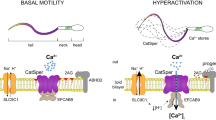Abstract.
Untangling the molecular nature of sperm-egg interactions is fundamental if we are to understand fertilization. These phenomena have been studied for many years using biochemical approaches such as antibodies and ligands that interact with sperm or with eggs and their vestments. However, when homologous genetic recombination techniques were applied, most of the phenotypic factors of the gene-manipulated animals believed “essential” for fertilization were found to be dispensable. Of course, all biological systems contain redundancies and compensatory mechanisms, but as a whole the old model of fertilization clearly requires significant modification. In this review, we use the results of gene manipulation experiments in animals to propose the basis for a new vision.
Similar content being viewed by others
Author information
Authors and Affiliations
Corresponding author
Additional information
Received 26 January 2007; received after revision 7 March 2007; accepted 17 April 2007
Rights and permissions
About this article
Cite this article
Okabe, M., Cummins, J.M. Mechanisms of sperm-egg interactions emerging from gene-manipulated animals. Cell. Mol. Life Sci. 64, 1945–1958 (2007). https://doi.org/10.1007/s00018-007-7037-7
Published:
Issue Date:
DOI: https://doi.org/10.1007/s00018-007-7037-7




